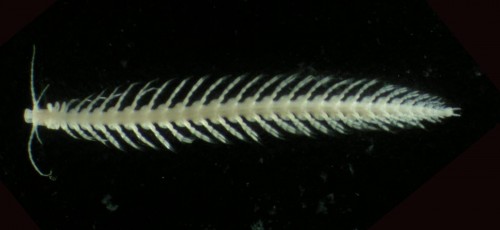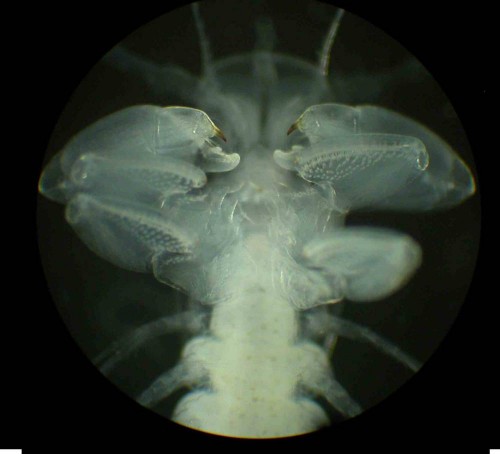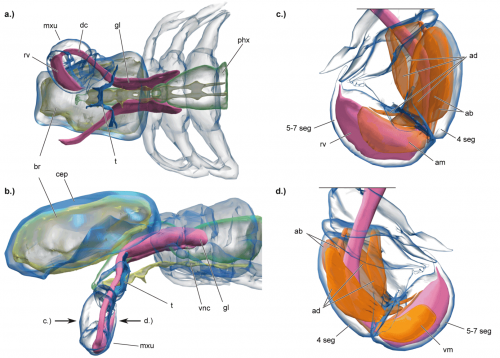I had no idea such things existed, but behold the remipede:
Yes, it’s a crustacean, although it doesn’t look like any I’ve seen before. You’re not likely to run into them casually; they’re found deep in Central American caves, with one species found in the Canary Islands and another in Western Australia. Besides being weird-looking critters, they’re also the only known venomous crustacean. Take a look at that clawed face!
There are no known instances of humans being bitten by one of these things — they aren’t exactly living underfoot. They have big sacs inside those front claws that contain a cocktail of proteases, chitinases, and a neurotoxin.
They poison their prey with an injection of a poisonous mixture that simultaneously paralyzes or kills them, and reduces their guts to a slurry that can be sucked out.
This toxin is represented by two distinct contigs that have the conserved cysteine pattern characteristic of β/δ agatoxins with virtually identical spacing [C-x(6)-C-x(6)-C-C-x(4)-C-x-C-x(6)-C-x-C] (Figure 5). β/δ agatoxins are a recently described type of spider venom neurotoxin (Billen et al. 2010), which causes pre-synaptic voltage-gated sodium channels to open at resting membrane potentials in insects. The resulting neurotransmitter release generates a stream of action potentials in motorneurons, resulting in irreversible spastic paralysis of the victim.
Charming!
von Reumont BM, Blanke A, Richter S, Alvarez F, Bleidorn C, Jenner RA. (2013) The first venomous crustacean revealed by transcriptomics and functional morphology: remipede venom glands express a unique toxin cocktail dominated by enzymes and a neurotoxin. Mol Biol Evol. 2013 Oct 16. [Epub ahead of print]





That is so cool.
Of course it is found in Australia… Everything is trying to kill you there…
One of the other cool things about remipedes is that they render Crustacea paraphyletic, because they’re more closely related to insects than to most other crustaceans.
johnharshman beat me to it, but here‘s a visual illustration of the point.
Another cool thing: the reason they look so very different from what ‘crustacean’ normally brings to mind is because, like centipedes, they retain much of the ancestral body plan of arthropods, i.e. many identical segments each with a single pair of (for the most part identical) appendages.
Except some of the sheep.
Via the wikipedia page, one of the families of remipede is Godzilliidae.
*loud exhale*
No one has lived to tell the tale.
So it’s chemically similar to draft beer at a bar that doesn’t clean their tap lines often enough then?
Halloween costume idea! Thanks PZ!
And here I was expecting something about the US right wing.
I’m guessing the feather look is a camaphlage.
I first learned of remipedes from the Octonauts.
The show illustrates that
1) they swim upside down,
2) they’re blind, and
3) they speak with an accent I can’t quite place.
a what, now?
Yay, Octonauts!
Boo, BBC Worldwide, for blocking the video even though I actually pay your license fee. *grump*
I shall have to settle for the Octonaut Wiki. Thank you Google!
(Octonaut Wiki! Who knew?! *shakes head*)
Could they be ancestral to both crustaceans and insects, an older form of arthropod than either? The distribution sounds like they’ve been widespread a long time ago or local to an area when Australia, Northern Africa, and Central America were all relatively close together.
no, they have typical crustacean heads (2 pairs of anterior antennae, then mandibles, then 2 more pairs of mouthparts), and genetic data place them as members of the sister group to hexapods.
No (In addition to ChasCPetersson’s no). No extant group is extant to any other extant group, nor are remipedes any older than any other arthropods. It’s like asking if gorillas could be ancestral to both chimps and humans. While the common ancestor of all Pancrustacea could conceivably (and perhaps this is even likely) have looked more like a remipede than most arthropods do, it wasn’t a remipede. The only way either of these scenarios would work would be if remipedes (or gorillas) were paraphyletic, with some more closely related to crustaceans (or African apes) than to each other.
Actually, Chas, your first objection isn’t valid. The common ancestor of Pancrustacea certainly would have had 2 pairs of antennae, mandibles, and two more pairs of mouthparts.
Curse you, typos. “No extant group is ancestral to any other extant group”.
true.
But ML was not talking about the common ancestor of Pancrustacea, (s)he was talking about remipedes, which, because of their head appendages, belong solidly within crown-group (i.e. extant) crustaceans.
The common ancestor of Pancrustacea was indeed a crown group crustacean, by definition, and must have possessed all the characters of crown group crustaceans, including the ones you meantion. Which is to say that those characters do not imply that are disqualified from being are ancestral to both crustaceans and insects, i.e. that remipedes are the common ancestor of Pancrustacea, which was indeed ML’s speculation.